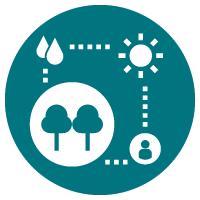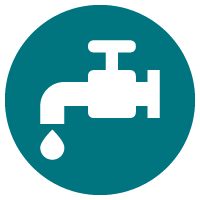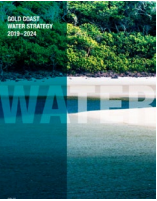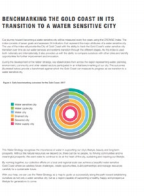City of Gold Coast water sensitive city transition strategy
Contact
Insight:
The drivers
Develop a vision and strategy to transition to a water sensitive Gold Coast
- Effects of climate change - Increased uncertainty and degrees of extremity in rainfall patterns are affecting the reliability, effectiveness and sustainability of current water services.
- Growing population and expectations for liveability - By 2040 the Gold Coast’s population is projected to increase from 600,000 to 940,000. The city’s waterways and beaches are one of the primary reasons people choose to live and visit the Gold Coast, so protecting these natural assets is very important to community values and the Gold Coast’s iconic water lifestyle.
- Geographical landscape - The length of the city and its low lying form presents challenges to water service network planning and flood preparedness. However, the city boundaries encompass most of the city’s waterways from headwaters to coast, providing a unique opportunity to manage them in a more integrated manner.
- Ageing infrastructure - Ageing infrastructure (water and sewerage networks, stormwater networks) and constructed water bodies (lakes and canals), changing community expectations and infrastructure standards will impact the city’s capital and operational expenditure.
- Governance - Water supply distribution, sewerage, stormwater and recycled water networks, flood planning, and catchment and waterway services are governed within City of Gold Coast, providing a unique opportunity to address institutional barriers that limit innovation.
The innovations
Early adoption of the Water Sensitive Cities Transition Planning Process by City of Gold Coast to set a vision and direction for its water sensitive future
- Extensive engagement to develop meaningful vision and actions - The CRCWSC facilitated stakeholder discussions across a series of five one-day workshops, stakeholder interviews and focus groups, drawing on a literature review and the application of benchmarking and diagnostic tools to inform detailed analysis.
- Setting a 50-year vision for Water Sensitive Gold Coast - 10 key vision outcomes were developed through agreed stakeholder aspirations which will help the Gold Coast to become a world leading water sensitive city:1. Water and land environments and resources are well-protected and enhance community health, wellbeing and safety.
2. All urban areas have abundant beautiful, well designed spaces that celebrate water and bring people together.
3. The Gold Coast’s communities share access to water environments, which supports their identity and lifestyle.
4. Water systems, infrastructure and land-use planning are integrated, deliver multiple benefits, and are adaptive to changing circumstances.
5. Water infrastructure systems enable efficient and sustainable use of resources to maximise social economic and environmental outcomes.
6. Water systems are innovative, support a diverse and sustainable economy and help shape the Gold Coast as a world leading water sensitive city.
7. People understand, cherish and protect their surrounding water environments.
8. Collaboration delivers sustainability goals and supports environmental stewardship.
9. Water decisions are made through informed and inclusive processes to support social, economic and environmental sustainability.
10.The Yugambeh people are actively engaged in water decision making, knowledge sharing and the stewardship of water and land environments. - Actions developed based on WSC Index Tool and Transition Dynamics Framework The WSC Index Tool was used to benchmark the Gold Coast’s current water sensitive performance against a number of WSC goals for the region. The Transition Dynamics Framework was then used to analyse the current enabling environment for the WSC goals, to identify priority actions as part of a strategy to support a meaningful transition to a water sensitive Gold Coast.
- Framework outputs led to development of the Water Strategy The outputs of the WSC Index Tool and Transition Dynamics Framework formed the foundation of the development of the City of Gold Coast Water Strategy. The Water Strategy communicates Council’s commitment to the community, with a bold vision and direction to manage water environments and resources sustainably over the next 20 years. The Water Strategy consists of four strategic outcomes and a suite of key transformational actions that align to the Transition Dynamics Framework and its priority objectives, strategies and vision statements to support the transition towards a water sensitive city.
- Water sensitive network formed A water sensitive city network was subsequently formed to continue the crucial community, industry, research and government partnerships.
Project stats
Location
Gold Coast, Queensland, Australia
Dates
August 2019
Participants
Topics
Enabling structures:
- Vision and Narrative
- Governance and Policy
- Evaluation frameworks
- Leadership and Influence
Benefits:
Contact
The outcomes
 Cities providing ecosystem services
Cities providing ecosystem services

- Build knowledge across water catchments, groundwater and constructed water bodies.
- Improve habitat and waterway stability through stabilising river banks, revegetating riparian zones, and creating waterway assets and habitats that improve water ecology.
- Improve natural flow of waterways and fish passage where feasible.
 Cities as water supply catchments
Cities as water supply catchments

• Value our resources through improving efficiency and effectiveness of water networks, and optimising recycled water, energy and resource production.
• Provide integrated and adaptive water sensitive planning for future services.
• Be innovative and sustainable through sharing knowledge, supporting innovation, conducting research and exploring alternative funding solutions.
• Plan for water being central to our city design through sustainable planning and development approaches, and integrated stormwater management solutions.
 Cities comprising water sensitive communities
Cities comprising water sensitive communities

• Continue engaging with partners and the community around the Water Strategy and its WSC actions.
• Foster a network of organisational and community champions who encourage collaboration, innovation and capability to help drive the Water Strategy WSC actions.
• Foster knowledge and education, and encourage participation through programs and advocating community led initiatives that increase water knowledge and improve water health.
• Promote the respect and collaboration for the cultural value and connection to waterways through arts, design and culture.
• Create green and blue urban spaces with multiple benefits to improve access, city cooling and community enjoyment.
• Support an adaptive and resilient city through resilience strategies and community preparedness.
Interested in this solution?
We partner with small and large companies, government and industry in Australia and around the world.



Comments